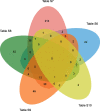Transcriptome profiling of lung immune responses potentially related to acute respiratory distress syndrome in forest musk deer
- PMID: 36221054
- PMCID: PMC9552132
- DOI: 10.1186/s12864-022-08917-7
Transcriptome profiling of lung immune responses potentially related to acute respiratory distress syndrome in forest musk deer
Abstract
Background: Forest musk deer is an endangered species globally. The death of captive forest musk deer can be caused by certain respiratory system diseases. Acute respiratory distress syndrome (ARDS) is a huge threat to the life of forest muck deer that breed in our department.
Methods: Lung histopathologic analysis was conducted by hematoxylin and eosin (HE) staining. The lung gene changes triggered by ARDS were examined by RNA sequencing and related bioinformatics analysis in forest musk deer. The potential functions of unigenes were investigated by NR, SwissProt KOG, GO, and KEGG annotation analyses. Vital biological processes or pathways in ARDS were examined by GO and KEGG enrichment analyses.
Results: A total of 3265 unigenes were differentially expressed (|log2fold-change|> 2 and adjusted P value < 0.01) in lung tissues of 3 forest musk deer with ARDS compared with normal lung tissues of the non-ARDS group. These differentially expressed unigenes (DEGs) played crucial roles in immunity and defense responses to pathogens. Moreover, we identified the DEGs related to one or more of the following biological processes: lung development, immunity, and bacterial/viral/fungal infection. And six DEGs that might be involved in lung injury caused by immune dysregulation or viral/fungal infection were identified.
Conclusion: ARDS-mediated lung gene alterations were identified in forest musk deer. Moreover, multiple genes involved in lung development and lung defense responses to bacteria/viruses/fungi in ARDS were filtered out in forest musk deer.
Keywords: Bacterium; Forest musk deer; Fungus; Immunity; Lung; RNA sequencing; Virus.
© 2022. The Author(s).
Conflict of interest statement
The authors declare that they have no financial conflicts of interest.
Figures





Similar articles
-
Illumina-based de novo transcriptome sequencing and analysis of Chinese forest musk deer.J Genet. 2017 Dec;96(6):1033-1040. doi: 10.1007/s12041-017-0872-x. J Genet. 2017. PMID: 29321364
-
SSR Marker Acquisition and Application from Transcriptome of Captive Chinese Forest Musk Deer (Moschus berezovskii).Biochem Genet. 2024 Aug;62(4):3215-3230. doi: 10.1007/s10528-023-10595-3. Epub 2023 Dec 14. Biochem Genet. 2024. PMID: 38095737
-
The blood transcriptome of musk deer under heat stress condition reveals the regulatory mechanism of genes to maintain homeostasis metabolism.BMC Genomics. 2025 Apr 24;26(1):400. doi: 10.1186/s12864-025-11577-y. BMC Genomics. 2025. PMID: 40275126 Free PMC article.
-
[Research progress on molecular genetics of forest musk deer].Zhongguo Zhong Yao Za Zhi. 2015 Nov;40(22):4319-23. Zhongguo Zhong Yao Za Zhi. 2015. PMID: 27097400 Review. Chinese.
-
[Research progress on musk and artificial propagation technique of forest musk deer].Zhongguo Zhong Yao Za Zhi. 2018 Oct;43(19):3806-3810. doi: 10.19540/j.cnki.cjcmm.20180726.004. Zhongguo Zhong Yao Za Zhi. 2018. PMID: 30453702 Review. Chinese.
Cited by
-
The virome investigation of the globally endangered Eld's deer (Rucervus eldii) on Hainan Island, China.Sci Rep. 2025 Mar 11;15(1):8384. doi: 10.1038/s41598-025-92781-4. Sci Rep. 2025. PMID: 40069308 Free PMC article.
References
-
- Wang Y, Harris R. Moschus berezovskii.(errata version published in 2016) The IUCN Red List of Threatened Species 2015: e. T13894A103431781(downloaded on 09 January 2017) 2015.
-
- Yang Q, Meng X, Xia L, Feng Z. Conservation status and causes of decline of musk deer (Moschus spp.) in China. Biol Conserv. 2003;109(3):333–342. doi: 10.1016/S0006-3207(02)00159-3. - DOI
-
- Guan T-L, Zeng B, Peng Q-K, Yue B-S, Zou F-D. Microsatellite analysis of the genetic structure of captive forest musk deer populations and its implication for conservation. Biochem Syst Ecol. 2009;37(3):166–173. doi: 10.1016/j.bse.2009.04.001. - DOI
MeSH terms
Substances
Grants and funding
- 2018K-01, Grant No. 2021K-37/Science and Technology Projects of Shaanxi Academy of Science, China
- 2018K-01, Grant No. 2021K-37/Science and Technology Projects of Shaanxi Academy of Science, China
- 2018K-01, Grant No. 2021K-37/Science and Technology Projects of Shaanxi Academy of Science, China
- 2018K-01, Grant No. 2021K-37/Science and Technology Projects of Shaanxi Academy of Science, China
- 2018K-01, Grant No. 2021K-37/Science and Technology Projects of Shaanxi Academy of Science, China
- 2018K-01, Grant No. 2021K-37/Science and Technology Projects of Shaanxi Academy of Science, China
- SXLK2021-0222/Foundation of Shaanxi Academy of Forestry, China
- SXLK2021-0222/Foundation of Shaanxi Academy of Forestry, China
- SXLK2021-0222/Foundation of Shaanxi Academy of Forestry, China
- SXLK2021-0222/Foundation of Shaanxi Academy of Forestry, China
- SXLK2021-0222/Foundation of Shaanxi Academy of Forestry, China
- SXLK2021-0222/Foundation of Shaanxi Academy of Forestry, China
LinkOut - more resources
Full Text Sources
Molecular Biology Databases

